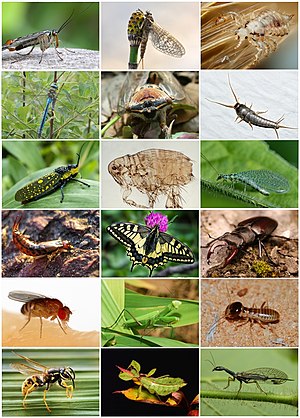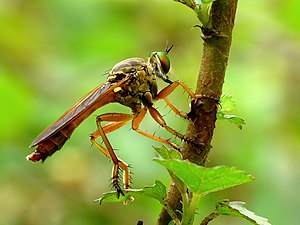
A | B | C | D | E | F | G | H | CH | I | J | K | L | M | N | O | P | Q | R | S | T | U | V | W | X | Y | Z | 0 | 1 | 2 | 3 | 4 | 5 | 6 | 7 | 8 | 9
| Insect Temporal range:
| |
|---|---|
 | |
| A wide diversity of insects from various orders. Insects have a three-part body: head with large compound eyes and antennae, a thorax with three pairs of legs and often wings, and a segmented abdomen. | |
| Scientific classification | |
| Domain: | Eukaryota |
| Kingdom: | Animalia |
| Phylum: | Arthropoda |
| Clade: | Pancrustacea |
| Subphylum: | Hexapoda |
| Class: | Insecta Linnaeus, 1758 |
| Subgroups | |
| Synonyms | |
| |
Insects (from Latin insectum) are hexapod invertebrates of the class Insecta. They are the largest group within the arthropod phylum. Insects have a chitinous exoskeleton, a three-part body (head, thorax and abdomen), three pairs of jointed legs, compound eyes, and a pair of antennae. Insects are the most diverse group of animals, with more than a million described species; they represent more than half of all animal species.
The insect nervous system consists of a brain and a ventral nerve cord. Most insects reproduce by laying eggs. Insects breathe air through a system of paired openings along their sides, connected to small tubes that take air directly to the tissues. The blood therefore does not carry oxygen; it is only partly contained in vessels, and some circulates in an open hemocoel. Insect vision is mainly through their compound eyes, with additional small ocelli. Many insects can hear, using tympanal organs, which may be on the legs or other parts of the body. Their sense of smell is via receptors, usually on the antennae and the mouthparts.
Nearly all insects hatch from eggs. Insect growth is constrained by the inelastic exoskeleton, so development involves a series of molts. The immature stages often differ from the adults in structure, habit and habitat. Groups that undergo four-stage metamorphosis often have a nearly immobile pupa. Insects that undergo three-stage metamorphosis lack a pupa, developing through a series of increasingly adult-like nymphal stages. The higher level relationship of the insects is unclear. Fossilized insects of enormous size have been found from the Paleozoic Era, including giant dragonfly-like insects with wingspans of 55 to 70 cm (22 to 28 in). The most diverse insect groups appear to have coevolved with flowering plants.
Adult insects typically move about by walking and flying; some can swim. Insects are the only invertebrates that can achieve sustained powered flight; insect flight evolved just once. Many insects are at least partly aquatic, and have larvae with gills; in some species, the adults too are aquatic. Some species, such as water striders, can walk on the surface of water. Insects are mostly solitary, but some, such as bees, ants and termites, are social and live in large, well-organized colonies. Others, such as earwigs, provide maternal care, guarding their eggs and young. Insects can communicate with each other in a variety of ways. Male moths can sense the pheromones of female moths over great distances. Other species communicate with sounds: crickets stridulate, or rub their wings together, to attract a mate and repel other males. Lampyrid beetles communicate with light.
Humans regard many insects as pests, especially those that damage crops, and attempt to control them using insecticides and other techniques. Others are parasitic, and may act as vectors of diseases. Insect pollinators are essential to the reproduction of many flowering plants and so to their ecosystems. Many insects are ecologically beneficial as predators of pest insects, while a few provide direct economic benefit. Two species in particular are economically important and were domesticated many centuries ago: silkworms for silk and honey bees for honey. Insects are consumed as food in 80% of the world's nations, by people in roughly 3000 ethnic groups. Human activities are having serious effects on insect biodiversity.
Etymology
The word insect comes from the Latin word inseco, from in, "to cut up",[1] as insects appear to be cut into three parts. The Latin word was introduced by Pliny the Elder who calqued the Ancient Greek word ἔντομον éntomon "insect" (as in entomology) from ἔντομος éntomos "cut in pieces";[2] this was Aristotle's term for this class of life in his biology, also in reference to their notched bodies. The English word insect first appears in 1601 in Philemon Holland's translation of Pliny.[3][4]
Insects and other bugs
Distinguishing features
In common speech, insects and other terrestrial arthropods are often called bugs.[a] Entomologists to some extent reserve the name "bugs" for a narrow category of "true bugs", insects of the order Hemiptera, such as cicadas and shield bugs.[6] Other terrestrial arthropods, such as centipedes, millipedes, woodlice, spiders, mites and scorpions, are sometimes confused with insects, since they have a jointed exoskeleton.[7] Adult insects are the only arthropods that ever have wings, with up to two pairs on the thorax. Whether winged or not, adult insects can be distinguished by their three-part body plan, with head, thorax, and abdomen; they have three pairs of legs on the thorax.[8]
- Insects and other bugs that could be confused with them
-
Insect: Six legs, three-part body
(head, thorax, abdomen),
up to two pairs of wings -
Spider: eight legs,
two-part body -
Woodlouse: seven pairs of legs, seven body segments (plus head and tail)
-
Centipede: many legs,
one pair per segment -
Millipede: many legs,
two pairs per segment
Diversity

Estimates of the total number of insect species vary considerably, suggesting that there are perhaps some 5.5 million insect species in existence, of which about one million have been described and named.[9] These constitute around half of all eukaryote species, including animals, plants, and fungi.[10] The most diverse insect orders are the Hemiptera (true bugs), Lepidoptera (butterflies and moths), Diptera (true flies), Hymenoptera (wasps, ants, and bees), and Coleoptera (beetles), each with more than 100,000 described species.[9]
- Insects are extremely diverse. Five groups each have over 100,000 described species.
-
True bugs
(Hemiptera) -
Butterflies and moths
(Lepidoptera) -
Zdroj:https://en.wikipedia.org?pojem=Insect
Text je dostupný za podmienok Creative Commons Attribution/Share-Alike License 3.0 Unported; prípadne za ďalších podmienok. Podrobnejšie informácie nájdete na stránke Podmienky použitia.
Antropológia
Aplikované vedy
Bibliometria
Dejiny vedy
Encyklopédie
Filozofia vedy
Forenzné vedy
Humanitné vedy
Knižničná veda
Kryogenika
Kryptológia
Kulturológia
Literárna veda
Medzidisciplinárne oblasti
Metódy kvantitatívnej analýzy
Metavedy
Metodika
Text je dostupný za podmienok Creative
Commons Attribution/Share-Alike License 3.0 Unported; prípadne za ďalších
podmienok.
Podrobnejšie informácie nájdete na stránke Podmienky
použitia.
www.astronomia.sk | www.biologia.sk | www.botanika.sk | www.dejiny.sk | www.economy.sk | www.elektrotechnika.sk | www.estetika.sk | www.farmakologia.sk | www.filozofia.sk | Fyzika | www.futurologia.sk | www.genetika.sk | www.chemia.sk | www.lingvistika.sk | www.politologia.sk | www.psychologia.sk | www.sexuologia.sk | www.sociologia.sk | www.veda.sk I www.zoologia.sk








